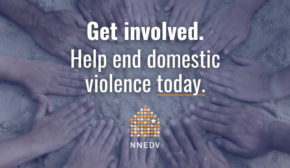Housing Policy
Issue Overview
Domestic violence and sexual assault are significant contributors to family homelessness and serve as both a cause and an outcome of housing instability.1 Survivors of domestic violence often must flee their homes to escape life-threatening violence. Victims of domestic violence are often punished for the actions of their abusive partners and face unfair eviction or denial of housing benefits.
Survivor-centered housing programs and housing protections increase survivors’ access to safe, affordable housing, a crucial step on the pathway to long-term security. The National Network to End Domestic Violence (NNEDV) works with national housing and homeless organizations to ensure that the housing needs of victims of domestic violence are being met through domestic violence-specific legislation, federal housing legislation, and federal regulations.
Learn more about domestic violence, housing, and homelessness from NNEDV’s Collaborative Approaches to Housing for Survivors team.
Violence Against Women Act (VAWA) Housing Protections and Domestic Violence Housing Programs
Victims of domestic violence are often punished for the actions of their abusive partners. For example, victims of domestic violence living in public housing sometimes face unfair eviction and denial of housing benefits. The landmark housing provisions passed in the 2005 VAWA reauthorization are designed to protect victims from such housing discrimination and allow them to access the criminal justice system while maintaining their housing.
VAWA housing protections allow public housing agencies (PHAs) to prioritize victims for housing when their safety dictates it, prohibit PHAs from denying housing or evicting a victim based solely on grounds of domestic violence, and clarify portability of Housing Choice Vouchers for victims. VAWA 2013, signed into law in March 2013, builds on the 2005 law.
The law expands to cover the following federally subsidized housing programs:
- S. Department of Agriculture Rural Housing properties;
- Low-Income Housing Tax Credit properties;
- S. Department of Housing and Urban Development McKinney-Vento homeless programs;
- The HOME Investment Partnerships program;
- The Section 221(d)(3) Below Market Interest Rate Program; and
- The Section 236 Rental Program, Housing Opportunities for Persons with AIDS, Section 202 supportive housing for the elderly, and Section 811 supportive housing for people with disabilities.
The law also expands protections to victims of sexual assault and requires housing programs to adopt emergency housing transfer policies.
For more information, see Safe Housing Partnerships.
VAWA housing protections are designed to allow victims to maintain or access safe housing, and yet the lack of consistent implementation has limited the effectiveness of these protections. Many of the housing provisions and protections under VAWA are not fully executed at the local level.
HUD issued a final rule on the VAWA housing protections in October 2010 that, by and large, responds to advocates’ concerns. The final rule will help foster consistent implementation and provide clearer guidance to housing providers on how to apply the VAWA housing protections. The final rule also indicates that HUD will continue to provide further guidance on the housing protections. Clearly, the new protections, covering additional programs, will require swift and consistent implementation as well.
Additionally, VAWA requires grantees and subgrantees to maintain the confidentiality of personally identifying victim information. It prohibits disclosure of personally identifying information or individual information collected in connection with services requested, utilized, or denied through grantees’ and subgrantees’ programs without the informed, written, reasonably time-limited consent of the person.
Federally Funded Domestic Violence Housing Programs
Many victims fleeing violence need safe, affordable housing after leaving shelter; otherwise, they may be forced to return to their abusers or live on the streets. Two federal grant programs create housing options for survivors:
- The VAWA Transitional Housing program, administered by the U.S. Department of Justice, Office on Violence Against Women, supports critical interim housing programs that help victims and their families rebuild their lives after escaping abuse.
- The Domestic Violence bonus funds in the HUD Continuum of Care Homelessness Assistance grant program provide rapid rehousing and other housing options to survivors.
Congress must fund these vital programs. In addition to funding streams, NNEDV supports legislative fixes to increase housing options for survivors. We are a partner in the Domestic Violence and Housing Technical Assistance Consortium (DVHTAC) and work with local communities to design and implement safe housing options for survivors. Contact us for more information.
HMIS and Confidentiality
Victim confidentiality is essential to maintain victim safety. NNEDV works with policymakers to ensure that local domestic violence service providers do not have to provide identifying information on victims to HUD’s Homelessness Management Information System (HMIS) and other third-party databases.
Learn more about HMIS and confidentiality for victims.
1 See generally:
- Los Angeles Women’s Need Assessment (2019) Retrieved from https://www.downtownwomenscenter.org/wp-content/uploads/2020/01/DWC-2019-Los-Angeles-Womens-Needs-Assessment.pdf.
- Journal of American Medical Women’s Association, 53(2), 57-64. Homelessness in Minnesota 2003;
- Levin, R., McKean, L, & Raphael, J. (2014). Pathways to and from homelessness: Women and children in Chicago shelters. Retrieved from http://www.issuelab.org/resources/346/346.pdf;

